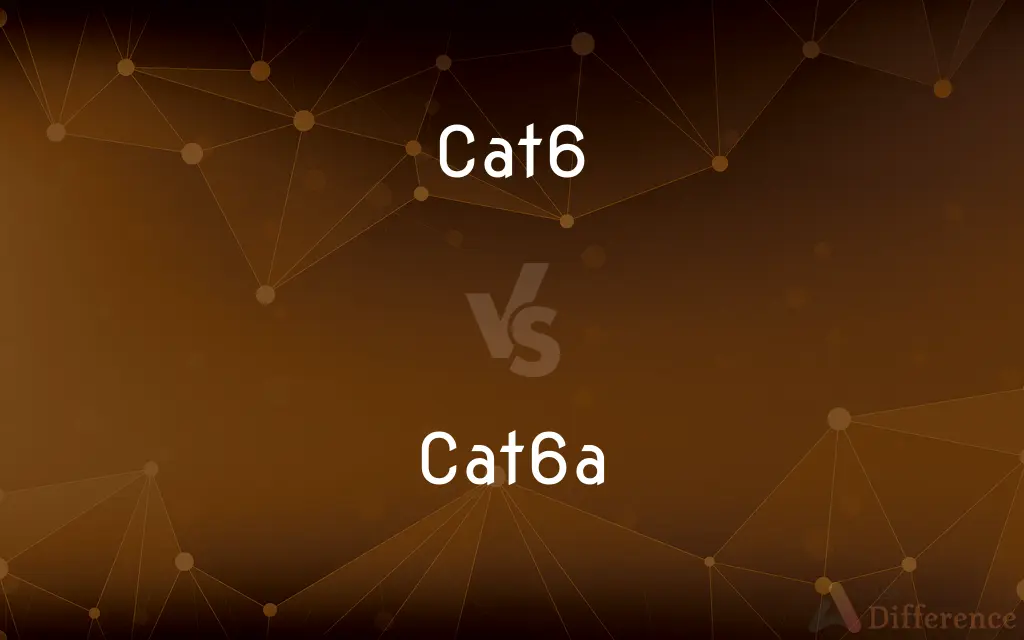Cat6 vs. Cat6a — What's the Difference?
By Tayyaba Rehman — Published on December 7, 2023
Cat6 and Cat6a are Ethernet cables, with Cat6a offering better performance and reduced interference compared to Cat6.

Difference Between Cat6 and Cat6a
Table of Contents
ADVERTISEMENT
Key Differences
Cat6 and Cat6a represent two different standards for Ethernet cables. Both play crucial roles in networking and are utilized to connect computers to networks. While Cat6 has been a longstanding standard, Cat6a was developed as an enhancement.
When observing performance, Cat6 provides data transfer rates up to 10 Gbps at 250 MHz, while Cat6a offers the same 10 Gbps but doubles the bandwidth to 500 MHz. This enhanced capability means Cat6a can handle faster data transfers over longer distances.
Interference is a significant concern in cabling. Cat6a stands out by offering superior shielding, which means reduced crosstalk and interference. While Cat6 cables are efficient, Cat6a cables have been designed to handle environments with a higher potential for interference.
Speaking of distance, Cat6 cables can achieve 10 Gbps speeds over a maximum distance of 55 meters. In contrast, Cat6a can maintain these speeds up to 100 meters. This makes Cat6a a more suitable choice for larger installations or where devices are further apart.
In terms of physical structure, Cat6a cables are typically thicker than Cat6 due to the enhanced shielding. This might make Cat6a slightly more challenging to install in tight spaces but ensures better performance and reduced interference.
ADVERTISEMENT
Comparison Chart
Maximum Bandwidth
250 MHz
500 MHz
Max Data Rate
10 Gbps
10 Gbps
Max Distance for 10 Gbps
55 meters
100 meters
Shielding
Some varieties shielded
Improved shielding
Physical Thickness
Generally thinner
Thicker due to better shielding
Compare with Definitions
Cat6
Cable designed to reduce interference and crosstalk.
We chose Cat6 for its enhanced signal integrity over older versions.
Cat6a
Cable designed for longer distances while maintaining high speeds.
With Cat6a, we can achieve 10 Gbps speeds up to 100 meters.
Cat6
Sixth generation of twisted pair Ethernet cabling.
Cat6 is an improvement over the previous Cat5e standard.
Cat6a
Thicker Ethernet cable due to additional shielding.
Installing Cat6a required some adjustments due to its increased thickness.
Cat6
Cable capable of 10 Gbps speeds up to 55 meters.
For shorter distances, Cat6 is both effective and cost-efficient.
Cat6a
Latest standard ensuring reduced crosstalk and better overall performance.
The network upgrades included a switch to Cat6a for its enhanced capabilities.
Cat6
An Ethernet cable standard supporting up to 10 Gbps.
For our office setup, we primarily use Cat6 cables due to their reliability.
Cat6a
Augmented version of Cat6 cable with improved shielding.
We opted for Cat6a in areas with high electromagnetic interference.
Cat6
A networking cable with a bandwidth of 250 MHz.
Cat6 provides adequate speed for most of our data transfer needs.
Cat6a
An advanced Ethernet cable supporting up to 10 Gbps with a bandwidth of 500 MHz.
For our new data center, we're installing Cat6a cables for optimal performance.
Common Curiosities
Do both Cat6 and Cat6a support Power over Ethernet (PoE)?
Yes, both can support PoE, but ensure other components like switches also support it.
Are Cat6a cables more expensive than Cat6?
Generally, Cat6a is pricier due to its enhanced features and performance.
How can I identify whether a cable is Cat6 or Cat6a?
Typically, the cable will be labeled or imprinted with its category.
Are there any downsides to using Cat6a?
It's generally more expensive and thicker, which might complicate installation in tight spaces.
Which cable is better for longer distances at high speeds?
Cat6a is better for longer distances, maintaining 10 Gbps up to 100 meters.
Why is Cat6a thicker than Cat6?
Cat6a is thicker due to its improved shielding, which reduces interference.
Is the installation process different for Cat6 and Cat6a?
Installation is similar, but Cat6a's thickness might require more space or larger conduits.
Do I need special connectors for Cat6a?
Cat6a may require connectors designed for its thickness and shielding.
Can I use Cat6 and Cat6a cables interchangeably?
Yes, both are compatible with Ethernet devices, but performance may vary based on the cable used.
Is Cat6a the latest Ethernet cable standard?
No, there are newer standards like Cat7 and Cat8, but Cat6a remains popular for many installations.
Can Cat6 handle 10 Gbps speeds?
Yes, but only up to 55 meters. Beyond that, speeds decrease.
Which cable is more future-proof, Cat6 or Cat6a?
Cat6a, due to its better performance and longer high-speed distance.
How do Cat6 and Cat6a compare to older standards like Cat5e?
Both offer better performance, speed, and reduced interference compared to Cat5e.
Which is better for a home network, Cat6 or Cat6a?
While both can work, Cat6a is more future-proof, but Cat6 might be adequate for many home setups.
What's the main advantage of Cat6 over Cat6a?
Cat6 is often less expensive and might suffice for shorter distances and lower interference environments.
Share Your Discovery

Previous Comparison
Ferrous Fumarate vs. Ferrous Sulfate
Next Comparison
Cat5e vs. Cat6Author Spotlight
Written by
Tayyaba RehmanTayyaba Rehman is a distinguished writer, currently serving as a primary contributor to askdifference.com. As a researcher in semantics and etymology, Tayyaba's passion for the complexity of languages and their distinctions has found a perfect home on the platform. Tayyaba delves into the intricacies of language, distinguishing between commonly confused words and phrases, thereby providing clarity for readers worldwide.












































